Page Contents :
How Chain Connect Blocks And Form Blockchain Network
Assuming the human body is analogized to the network of the blockchain.
Then the organs in the human body are like Nodes in the blockchain, with complete genetic memory ( Encrypted Hash value ).
Each organ connects ( Chain ) the cells ( Block ) of the human body in a perfect arrangement, allowing the organs of the human body to function independently.
Organs are connected by veins, very much like a complete Blockchain Network.
In the previous post Block Of Blockchain ![]() , we have studied that the newly generated block should contain the encrypted hash value of the previous block before we can chain it to the blockchain.
, we have studied that the newly generated block should contain the encrypted hash value of the previous block before we can chain it to the blockchain.
It is through this hash value verification method that we chain the valid block to the previous block, thereby chain to the blockchain Genesis Block ![]() .
.
Since each block contains the hash of the previous block and is hashed to form a valid block.
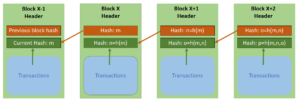
We already know that the hash value ( hash: m ) of the 1st block (or Genesis Block) will be stored in the 2nd block.
The 3rd block contains the hash value of the 2nd block ( hash: m,n ), and the hash value of the 2nd block is determined by the hash value produced by the 1st block ( hash: m ).
In a sense, the 3rd block is chained through the interrelationships of all their hashes ( hash: m,n ) which included the hash of the 1st block ( hash: m).
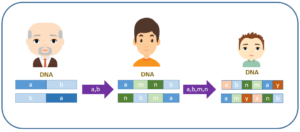
It’s as is I inherited my father’s genes (DNA) and my son inherited my genes and also has my father’s genes. We are associated by this genetic blood relationship, forming an Immediate Family Tree.
This is the real immutability of the blockchain and the reason for its immutability.
Hence, for example, a block at height X in the blockchain, its associated data, hash value, and Nonce value, in the event that there is any change, a ripple effect will happen.
Then, at that point, all the blocks toward the back (the Block X+1 that come afterwards of the block height X) won’t have any relationship with the previous block (the block height X), in other words, the latter block will completely become invalid.
Likewise, if the genes or organs of the human body are damaged, the entire human body can’t function perfectly.
In the Block Of Blockchain ![]() post, we mentioned that referencing the hash value of the previous block can prevent tampering!
post, we mentioned that referencing the hash value of the previous block can prevent tampering!

Assume MetaStone attempts to tamper with the transaction data in Block X, then I have to re-find a valid Nonce value to generate a new hash value “e”.
Assuming I chain this new Block X on the blockchain, since the reference hash value of block height X+1 still records the old hash value “n” of Block X, the reference hash value of Block X+1 not the same as the hash value of the newly generated Block X.
From that point forward, all blocks come subsequently the block height X (the block height X+1 and above) can not be able to be chained again and will be invalid.
Unless I control more than 51% of the computing power of the entire network, is it impossible for all blocks after height X to continue to be chained to the Block X that I tampered with.
This is the certainty that the distributed blockchain effect brings, and why it is considered irreversible and the only source of truth.
Everything About Blockchain Nodes!
Many people often ask what is a node? Let’s make it simple:
- Nodes are the essential hardware devices that make up a blockchain network, like computers, smartphones, laptops, or servers.
- The data of the blockchain is stored on the nodes of the decentralized server.
- Nodes are connected to one another, and in addition to storing blockchain data, they also continuously spread, exchange and update the latest information with each other.
- Nodes are the framework of the blockchain.
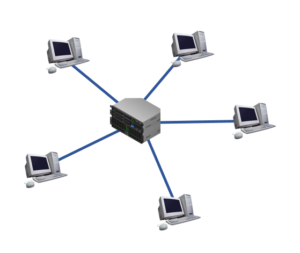
The traditional Internet is based on a Client / Server Structure.
In this architecture, any client that wants to interact with the central server needs to connect to the same server.
The disadvantages of this client/server architecture are:
- Since all computations, data, and communications are centralized in the central server, its operational throughput turns out to be extremely huge, and its bandwidth requirements become exceptionally high.
- The client must communicate with other clients through the central server, and they do not share resources with each other, and their data paths are not fully utilized.
- Once the server crashes or gets hacked, the system stops functioning completely. The risk of a single point of failure also increases accordingly.
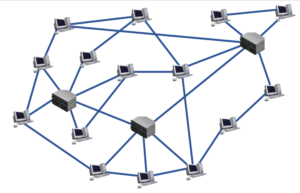
Contrasted to the client/server mode, it is a new generation of Peer-to-Peer Mode.
This mode connects two or more hardware devices together as peers.
The advantages of peer-to-peer mode are:
- Equal rights and privileges on the network, acting as both client and server.
- Sharing resources with each other means sharing storage, memory, bandwidth, and processing power.
- The information is distributed on multiple nodes, which can better adjust the load balancing of the network and maintain the connectivity of other nodes.
- Since the service is distributed among the various nodes, the disruption of some nodes or the network has little impact on other parts. It has the advantages of attack resistance and high fault tolerance.
The blockchain network is to connect all hardware devices together to form a network through a peer-to-peer mode. Ethereum and Bitcoin use this mode.
10 Types Of Blockchain Nodes You Will Be Interested To Know
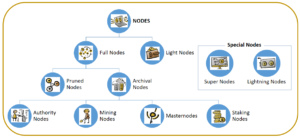
In short, there are two main types of nodes: Full Nodes and Light Nodes.
A full node contains all transaction records or copies in the blockchain. Its main function is to maintain consensus and transaction verification among other nodes.
Therefore, a full node is a server in the blockchain that manages the decentralized network and provides network security.
At the same time, it can make decisions for the network’s proposals and maintain mutual consensus.
Or called the Simple Payment Verification (SPV) node, which is a “light wallet” that we are familiar with.
It only downloads block headers, does not keep the complete transaction copies, but only saves transaction data related to itself.
So it must rely on full node operation to synchronize to the current state of the network and perform simple transaction verification.
Full nodes are further classified into: Pruned Nodes and Archival Nodes.
Although the entire blockchain is not downloaded locally, pruned nodes can still complete all transaction verification independently. It reduces the required memory space for its clients by “pruning” unnecessary data from old blocks.
Since the memory space of the node is limited. Therefore, when transaction data approaches the memory space limit, the node keeps its transaction data within the memory space limit in an optimized “pruning” mode.
Due to the existence of pruning nodes, the status of a certain block height can be quickly found by querying the transaction data in the blockchain.
The main difference between an archival node and a pruned node is the available memory space. For example, the archival node is 1.2TB, while the pruned node is only 430GB.
Archival nodes are the main nodes that make up the blockchain network. Mostly, when we refer to “full nodes”, we mean archival nodes.
In addition to retaining the complete transaction data, the archival node also stores the status of each block height and also records the transaction records that have occurred.
For example, we can quickly query the balance of a certain block height.
With the development of blockchain, archival nodes can be subdivided into the following 4 types: Authority Nodes, Mining Nodes, Masternodes and Staking Nodes.
Any hardware device can synchronize with blockchain data through its system and become a member or node in the public blockchain.
Authority nodes are nodes that control or are responsible for authorizing these hardware devices to join the blockchain network.
It can also define access by other nodes to some specific data channels.
For some consensus algorithms, such as Proof-of-Work (PoW) ![]() , high computation and solving complex mathematical functions are required to verify transaction records.
, high computation and solving complex mathematical functions are required to verify transaction records.
Mining nodes are specially created for mining and consume a lot of energy and computing power for consensus such as their mining work.
A masternode is a full node that has no power to add new block to the blockchain.
The role of masternodes is only to maintain the blockchain ledger and verify transactions.
The staking node is responsible for the verification of transactions in the blockchain network to maintain the consensus algorithm.
In the Proof-of-Stake (PoS) consensus mechanism, participants stake their funds to staking nodes and receive rewards after successfully validating transactions.
In addition to the 8 types of nodes mentioned above, there are 2 special nodes: Super Nodes and Lightning Nodes.
Super nodes add a decentralized voting mechanism based on PoS.
It is a specific practice for the third-generation verification and consensus mechanism – Delegated Proof-of-Stake (DPoS).
EOS adopts the DPoS consensus mechanism, and 21 super nodes maintain the EOS network.
Lightning nodes are mainly used to solve the transaction delay problem caused by blockchain network congestion.
This node and user create a separate Lightning Network to verify the transaction that is interacting directly within it.
LN could reduces the load on the blockchain network, improves transaction efficiency, and reduces transaction costs.
We will explore blockchain technology and architecture in more depth in upcoming posts.
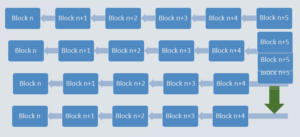
- Anyone can join, no permission is required.
- Nodes that make up a community can both share authority.
- After the blockchain accepts a valid block, it broadcasts it to other connected nodes.
- The blockchain synchronizes and updates data with other nodes.




